A Comparative Analysis of Remotely Sensed and High-Fidelity ArcSWAT Evapotranspiration Estimates Across Various Timescales in the Upper Anthemountas Basin, Greece
Abstract
1. Introduction
2. Materials and Methods
2.1. Study Area
2.2. General Methodological Framework
- Step 1: Hydrological Model Development and Input Data Preparation.
- Step 2: Model Initialization and Calibration.
- Step 3: Remote Sensing ET Product Acquisition and Processing.
- Step 4: ET Comparison Strategy.
2.3. Performance Evaluation Metrics
2.4. Hydrological Model Development
2.4.1. Description of the SWAT Model
2.4.2. Model Input Data Preparation
Climate Data
Topography (DEM)
Land Cover
Soil
2.4.3. Set up and Initial Model Run
2.4.4. Model Calibration Procedure
2.5. Satellite-Derived ET Datasets
3. Results and Discussion
3.1. Hydrological Model Results
3.1.1. Model Calibration and Evaluation
3.1.2. Water Balance Components and Discharge Hydrograph
3.2. Performance Analysis Between ArcSWAT-Simulated and Remotely Sensed ET Products
3.2.1. Overall Monthly Evolution of ET
3.2.2. Averaged Monthly ET Comparisons
3.2.3. Seasonal ET Comparisons
3.2.4. Annual ET Comparisons
3.2.5. Insights into Model–Satellite ET Agreement
3.2.6. Comparison of SWAT-Simulated and Satellite-Derived Evapotranspiration: Insights and Literature Context
4. Conclusions
- The hydrological model was calibrated using observed monthly streamflow records spanning 2004 to 2013, and the resulting performance was classified as satisfactory to very good, based on multiple established statistical evaluation metrics.
- Over the simulation period, mean actual evapotranspiration was estimated, on average, at 367.8 mm and emerged as the most significant component of the water balance, accounting for approximately 65% of total precipitation.
- Of all remote sensing-based ET datasets, MOD16A2-C5 exhibited the greatest agreement with the SWAT model outputs.
- MOD16A2GF-C6.1 demonstrated moderate overall agreement and tended to overestimate ET in most years, yet it outperformed all other products in representing early summer ET dynamics.
- The SSEBop-V5 product, while generally indicating weaker alignment with the modeled ET, displayed improved correspondence during the driest years of the simulation period.
- Across all temporal ET comparisons, averaging the values of all satellite-derived products yields a consistently strong agreement with the calibrated SWAT-simulated ET.
Author Contributions
Funding
Data Availability Statement
Acknowledgments
Conflicts of Interest
References
- Pan, S.; Pan, N.; Tian, H.; Friedlingstein, P.; Sitch, S.; Shi, H.; Arora, V.K.; Haverd, V.; Jain, A.K.; Kato, E.; et al. Evaluation of global terrestrial evapotranspiration using state-of-the-art approaches in remote sensing, machine learning and land surface modeling. Hydrol. Earth Syst. Sci. 2020, 24, 1485–1509. [Google Scholar] [CrossRef]
- Ghiat, I.; Mackey, H.R.; Al-Ansari, T. A review of evapotranspiration measurement models, techniques and methods for open and closed agricultural field applications. Water 2021, 13, 2523. [Google Scholar] [CrossRef]
- Rientjes, T.H.M.; Muthuwatta, L.P.; Bos, M.G.; Booij, M.J.; Bhatti, H.A. Multi-variable calibration of a semi-distributed hydrological model using streamflow data and satellite-based evapotranspiration. J. Hydrol. 2013, 505, 276–290. [Google Scholar] [CrossRef]
- Tobin, K.J.; Bennett, M.E. Constraining SWAT calibration with remotely sensed evapotranspiration data. JAWRA J. Am. Water Resour. Assoc. 2017, 53, 593–604. [Google Scholar] [CrossRef]
- Rajib, A.; Evenson, G.R.; Golden, H.E.; Lane, C.R. Hydrologic model predictability improves with spatially explicit calibration using remotely sensed evapotranspiration and biophysical parameters. J. Hydrol. 2018, 567, 668–683. [Google Scholar] [CrossRef]
- Parajuli, P.B.; Jayakody, P.; Ouyang, Y. Evaluation of using remote sensing evapotranspiration data in SWAT. Water Resour. Manag. 2018, 32, 985–996. [Google Scholar] [CrossRef]
- Herman, M.R.; Nejadhashemi, A.P.; Abouali, M.; Hernandez-Suarez, J.S.; Daneshvar, F.; Zhang, Z.; Anderson, M.C.; Sadeghi, A.M.; Hain, C.R.; Sharifi, A. Evaluating the role of evapotranspiration remote sensing data in improving hydrological modeling predictability. J. Hydrol. 2018, 556, 39–49. [Google Scholar] [CrossRef]
- Sirisena, T.J.G.; Maskey, S.; Ranasinghe, R. Hydrological model calibration with streamflow and remote sensing based evapotranspiration data in a data poor basin. Remote Sens. 2020, 12, 3768. [Google Scholar] [CrossRef]
- Dile, Y.T.; Ayana, E.K.; Worqlul, A.W.; Xie, H.; Srinivasan, R.; Lefore, N.; Dile, Y.T.; Ayana, E.K.; Worqlul, A.W.; Xie, H.; et al. Evaluating satellite-based evapotranspiration estimates for hydrological applications in data-scarce regions: A case in Ethiopia. Sci. Total Environ. 2020, 743s, 140702. [Google Scholar] [CrossRef]
- Shah, S.; Duan, Z.; Song, X.; Li, R.; Mao, H.; Liu, J.; Ma, T.; Wang, M. Evaluating the added value of multi-variable calibration of SWAT with remotely sensed evapotranspiration data for improving hydrological modeling. J. Hydrol. 2021, 603, 127046. [Google Scholar] [CrossRef]
- Sun, Z.; Lotz, T.; Huang, Q. An ET-based two-phase method for the calibration and application of distributed hydrological models. Water Resour. Manag. 2021, 35, 1065–1077. [Google Scholar] [CrossRef]
- Bennour, A.; Jia, L.; Menenti, M.; Zheng, C.; Zeng, Y.; Asenso Barnieh, B.; Jiang, M. Calibration and validation of SWAT model by using hydrological remote sensing observables in the Lake Chad Basin. Remote Sens. 2022, 14, 1511. [Google Scholar] [CrossRef]
- Alemayehu, T.; van Griensven, A.; Woldegiorgis, B.T.; Bauwens, W. An improved SWAT vegetation growth module and its evaluation for four tropical ecosystems. Hydrol. Earth Syst. Sci. 2017, 21, 4449. [Google Scholar] [CrossRef]
- Parajuli, P.B.; Risal, A.; Ouyang, Y.; Thompson, A. Comparison of SWAT and MODIS evapotranspiration data for multiple timescales. Hydrology 2022, 9, 103. [Google Scholar] [CrossRef]
- Koltsida, E.; Kallioras, A. Multi-variable SWAT model calibration using satellite-based evapotranspiration data and streamflow. Hydrology 2022, 9, 112. [Google Scholar] [CrossRef]
- Dangol, S.; Zhang, X.; Liang, X.Z.; Anderson, M.; Crow, W.; Lee, S.; Moglen, G.E.; McCarty, G.W. Multivariate calibration of the SWAT model using remotely sensed datasets. Remote Sens. 2023, 15, 2417. [Google Scholar] [CrossRef]
- Immerzeel, W.A.; Droogers, P. Calibration of a distributed hydrological model based on satellite evapotranspiration. J. Hydrol. 2008, 349, 411–424. [Google Scholar] [CrossRef]
- Verma, N. Simulation of hydrologic processes through SWAT and Modis ET for Sirsa River Basin in Western Himalaya. Int. J. Water Resour. Arid Environ. 2018, 7, 21–35. [Google Scholar]
- Odusanya, A.E.; Mehdi, B.; Schürz, C.; Oke, A.O.; Awokola, O.S.; Awomeso, J.A.; Adejuwon, J.O.; Schulz, K. Multi-site calibration and validation of SWAT with satellite-based evapotranspiration in a data-sparse catchment in southwestern Nigeria. Hydrol. Earth Syst. Sci. 2019, 23, 1113–1144. [Google Scholar] [CrossRef]
- Bárdossy, A.; Huang, Y.; Wagener, T. Simultaneous calibration of hydrological models in geographical space. Hydrol. Earth Syst. Sci. 2016, 20, 2913–2928. [Google Scholar] [CrossRef]
- Oliveira, A.M.; Fleischmann, A.S.; Paiva, R.C.D. On the contribution of remote sensing-based calibration to model hydrological and hydraulic processes in tropical regions. J. Hydrol. 2021, 597, 126184. [Google Scholar] [CrossRef]
- Michailovsky, C.I.; Coerver, B.; Mul, M.; Jewitt, G. Investigating sources of variability in closing the terrestrial water balance with remote sensing. Hydrol. Earth Syst. Sci. 2023, 27, 4335–4354. [Google Scholar] [CrossRef]
- Abbaspour, K.C.; Rouholahnejad, E.; Vaghefi, S.; Srinivasan, R.; Yang, H.; Klove, B. A continental scale hydrology and water quality model for Europe: Calibration and uncertainty of a high-resolution large-scale SWAT model. J. Hydrol. 2015, 524, 733–752. [Google Scholar] [CrossRef]
- Singh, G.; Kumar, E. Input data scale impacts on modeling output results: A review. J. Spat. Hydrol. 2017, 13, Article 4. [Google Scholar]
- Sevastas, S.; Siarkos, I.; Theodossiou, N.; Ifadis, I. Evaluating the use of measured and/or open access data in watershed modeling through an integrated modeling procedure. Desalination Water Treat. 2018, 133, 268–282. [Google Scholar] [CrossRef]
- Kumar, S.; Merwade, V. Impact of watershed subdivision and soil data resolution on SWAT model calibration and parameter uncertainty. JAWRA J. Am. Water Resour. Assoc. 2009, 45, 1179–1196. [Google Scholar] [CrossRef]
- Gregar, J.; Petrů, J.; Novotná, J. Evaluation of the SWAT model as an integrated management tool in the Švihov drinking water supply catchment. Soil Water Res. 2019, 14, 76–83. [Google Scholar] [CrossRef]
- Sevastas, S.; Siarkos, I.; Theodossiou, N.; Ifadis, I. Establishing wellhead protection areas and managing point and non-point pollution sources to support groundwater protection in the aquifer of Upper Anthemountas, Greece. Water Util. J. 2017, 16, 81–95. [Google Scholar]
- Sevastas, S.; Siarkos, I.; Theodossiou, N.; Ifadis, I.; Kaffas, K. Comparing hydrological models built upon open access and/or measured data in a GIS environment. In Proceedings of the 6th International Conference on Environmental Management, Engineering, Planning and Economics (CEMEPE) and SECOTOX Conference, Thessaloniki, Greece, 25–30 June 2017; pp. 377–386. [Google Scholar]
- Sevastas, S. Applying Geo-Information Systems, Numerical Models and Genetic Algorithms in Optimizing Groundwater Risk Assessment: A Case Study from the Upper Anthemountas River Basin. Ph.D. Thesis, Aristotle University of Thessaloniki, Thessaloniki, Greece, 2023. (In Greek). [Google Scholar]
- Sevastas, S.; Gasparatos, D.; Botsis, D.; Siarkos, I.; Diamantaras, K.I.; Bilas, G. Predicting bulk density using pedotransfer functions for soils in the Upper Anthemountas basin, Greece. Geoderma Reg. 2018, 14, e00169. [Google Scholar] [CrossRef]
- Misopolinos, N.; Silleos, N.; Kosmas, K.; Bilas, G.; Karapetsas, N.; Dionisiou, N. Development of an Integrated System for Soil Geographic Data and Delineation of Agricultural Zones in Greece; Payment and Control Agency for Guidance and Guarantee Community Aid (OPEKEPE) of the Greek Ministry of Agricultural Development and Food: Athens, Greece, 2015.
- Moriasi, D.N.; Arnold, J.G.; Van Liew, M.W.; Bingner, R.L.; Harmel, R.D.; Veith, T.L. Model evaluation guidelines for systematic quantification of accuracy in watershed simulations. Trans. ASABE 2007, 50, 885–900. [Google Scholar] [CrossRef]
- Kouchi, D.H.; Esmaili, K.; Faridhosseini, A.; Sanaeinejad, S.H.; Khalili, D.; Abbaspour, K.C. Sensitivity of calibrated parameters and water resource estimates on different objective functions and optimization algorithms. Water 2017, 9, 384. [Google Scholar] [CrossRef]
- Sao, D.; Kato, T.; Tu, L.H.; Thouk, P.; Fitriyah, A.; Oeurng, C. Evaluation of different objective functions used in the SUFI-2 calibration process of SWAT-CUP on water balance analysis: A case study of the Pursat river basin, Cambodia. Water 2020, 12, 2901. [Google Scholar] [CrossRef]
- Verma, S.; Verma, M.K.; Prasad, A.D.; Mehta, D.J.; Islam, M.N. Modeling of uncertainty in the estimation of hydrograph components in conjunction with the SUFI-2 optimization algorithm by using multiple objective functions. Model. Earth Syst. Environ. 2024, 10, 61–79. [Google Scholar] [CrossRef]
- Gupta, H.V.; Kling, H.; Yilmaz, K.K.; Martinez, G.F. Decomposition of the Mean Squared Error and NSE performance criteria: Implications for improving hydrological modelling. J. Hydrol. 2009, 377, 80–91. [Google Scholar] [CrossRef]
- Arnold, J.G.; Srinivasan, R.; Muttiah, R.S.; Williams, J.R. Large area hydrologic modeling and assessment part I: Model development. JAWRA J. Am. Water Resour. Assoc. 1998, 34, 73–89. [Google Scholar] [CrossRef]
- Winchell, M.; Srinivasan, R.; Di Luzio, M.; Arnold, J.G. Arcswat Interface for SWAT2012: User’s Guide; Blackland Research Center, Texas AgriLife Research: College Station, TX, USA, 2013; pp. 1–464.
- Monteiro, J.A.; Strauch, M.; Srinivasan, R.; Abbaspour, K.; Gücker, B. Accuracy of grid precipitation data for Brazil: Application in river discharge modelling of the Tocantins catchment. Hydrol. Process. 2016, 30, 1419–1430. [Google Scholar] [CrossRef]
- Roth, V.; Lemann, T. Comparing CFSR and conventional weather data for discharge and soil loss modelling with SWAT in small catchments in the Ethiopian Highlands. Hydrol. Earth Syst. Sci. 2016, 20, 921–934. [Google Scholar] [CrossRef]
- Arnold, J.G.; Kiniry, J.R.; Srinivasan, R.; Williams, J.R.; Haney, E.B.; Neitsch, S.L. SWAT Input/Output Documentation Version 2012; Texas Water Resources Institute: College Station, TX, USA, 2012; p. 654.
- Abbaspour, K.C.; Vaghefi, S.A.; Yang, H.; Srinivasan, R. Global soil, landuse, evapotranspiration, historical and future weather databases for SWAT Applications. Sci. Data 2019, 6, 263. [Google Scholar] [CrossRef]
- Wise, S. Cross-validation as a means of investigating DEM interpolation error. Comput. Geosci. 2011, 37, 978–991. [Google Scholar] [CrossRef]
- Acharya, T.D.; Yang, I. Exploring Landsat 8. Int. J. IT Eng. Appl. Sci. Res. (IJIEASR) 2015, 4, 4–10. [Google Scholar]
- Wang, D.; Zhan, Y.; Yu, T.; Liu, Y.; Jin, X.; Ren, X.; Chen, X.; Liu, Q. Improving meteorological input for surface energy balance system utilizing mesoscale weather research and forecasting model for estimating daily actual evapotranspiration. Water 2019, 12, 9. [Google Scholar] [CrossRef]
- Baig, M.H.A.; Zhang, L.; Shuai, T.; Tong, Q. Derivation of a tasselled cap transformation based on Landsat 8 at-satellite reflectance. Remote Sens. Lett. 2014, 5, 423–431. [Google Scholar] [CrossRef]
- Crist, E.P.; Kauth, R.J. The tasseled cap de-mystified. Photogramm. Eng. Remote Sens. 1986, 52, 81–86. [Google Scholar]
- Huang, C.; Wylie, B.; Yang, L.; Homer, C.; Zylstra, G. Derivation of a tasselled cap transformation based on Landsat 7 at-satellite reflectance. Int. J. Remote Sens. 2002, 23, 1741–1748. [Google Scholar] [CrossRef]
- Ghazali, M.F.; Susantoro, T.M.; Wikantika, K.; Harto, A.B.; Nurtyawan, R. Soil moisture mapping at paddy field in Indramayu Residence using Landsat 8 OLI/TIRS. HAYATI J. Biosci. 2020, 27, 71–81. [Google Scholar] [CrossRef]
- Aliaume, C.; Bodini, A.; Bondavalli, C.; Carreño, F.; Chapelle, A.; Duarte, P.; Esteve-Selma, M.A.; Falco, M.; Fiandrino, A.; Giordani, G.; et al. Model Benchmarks for Coastal Lagoons; EUR 22216EN.; European Commission, Joint Research Centre: Ispra, Italy, 2006; p. 82. [Google Scholar]
- Plus, M.; La Jeunesse, I.; Bouraoui, F.; Zaldívar, J.M.; Chapelle, A.; Lazure, P. Modelling water discharges and nitrogen inputs into a Mediterranean lagoon: Impact on the primary production. Ecol. Model. 2006, 193, 69–89. [Google Scholar] [CrossRef]
- Igder, O.M.; Alizadeh, H.; Mojaradi, B.; Bayat, M. Multivariate assimilation of satellite-based leaf area index and ground-based river streamflow for hydrological modelling of irrigated watersheds using SWAT+. J. Hydrol. 2022, 610, 128012. [Google Scholar] [CrossRef]
- Ma, T.; Duan, Z.; Li, R.; Song, X. Enhancing SWAT with remotely sensed LAI for improved modelling of ecohydrological process in subtropics. J. Hydrol. 2019, 570, 802–815. [Google Scholar] [CrossRef]
- Myneni, R.; Knyazikhin, Y.; Park, T. MODIS/Terra+ Aqua Leaf Area Index/FPAR 4-Day L4 Global 500 m SIN Grid V061; The Land Processes Distributed Active Archive Center (LP DAAC): Sioux Falls, SD, USA, 2021.
- Daneshvar, F.; Frankenberger, J.R.; Bowling, L.C.; Cherkauer, K.A.; de Lima Moraes, A.G. Development of strategy for SWAT hydrologic modeling in data-scarce regions of Peru. J. Hydrol. Eng. 2021, 26, 05021016. [Google Scholar] [CrossRef]
- Emberson, L.D. Development and Application of Methods for Modeling and Mapping Ozone Deposition and Stomatal Flux; Final Report; Department of Environment, Food and Regional Affairs: London, UK, 2003.
- Nelson, D.W.; Sommers, L.E. Total carbon, organic carbon, and organic matter. In Methods of Soil Analysis–Part 3 Chemical Methods; Sparks, D.L., Ed.; Soil Science Society of America: Fitchburg, MA, USA, 1996; pp. 961–1010. [Google Scholar]
- Pribyl, D.W. A critical review of the conventional SOC to SOM conversion factor. Geoderma 2010, 156, 75–83. [Google Scholar] [CrossRef]
- Bagarello, V.; Di Prima, S.; Iovino, M.; Provenzano, G. Estimating field-saturated soil hydraulic conductivity by a simplified Beerkan infiltration experiment. Hydrol. Process. 2014, 28, 1095–1103. [Google Scholar] [CrossRef]
- Penning de Vries, F.W.T.; Jansen, D.M.; ten Berge, H.F.M.; Bakema, A. Simulation of Ecophysiological Processes of GROWTH in Several Annual Crops; Centre for Agricultural Publishing and Documentation (Pudoc): Wageningen, The Netherlands, 1989. [Google Scholar]
- ten Berge, H.F.M. Heat and Water Transfer in Bare Topsoil and the Lower Atmosphere; Centre for Agricultural Publishing and Documentation (Pudoc): Wageningen, The Netherlands, 1996. [Google Scholar]
- Saxton, K.E.; Willey, P.H. The SPAW model for agricultural field and pond hydrologic simulation. In Watershed Models; Singh, V.P., Frevert, D.K., Eds.; CRC Press: Boca Raton, FL, USA, 2009; pp. 401–435. [Google Scholar]
- Williams, J.R. Chapter 25: The EPIC model. In Computer Models of Watershed Hydrology; Singh, V.P., Ed.; Resources Publications: Highlands Ranch, CO, USA, 1995; pp. 909–1000. [Google Scholar]
- Sheng, J.; Ma, L.; Jiang, P.A.; Li, B.; Huang, F.; Wu, H. Digital soil mapping to enable classification of the salt-affected soils in desert agro-ecological zones. Agric. Water Manag. 2010, 97, 1944–1951. [Google Scholar] [CrossRef]
- Akpa, S.I.; Odeh, I.O.; Bishop, T.F.; Hartemink, A.E. Digital mapping of soil particle-size fractions for Nigeria. Soil Sci. Soc. Am. J. 2014, 78, 1953–1966. [Google Scholar] [CrossRef]
- Boente, C.; Albuquerque, M.T.D.; Fernández-Braña, A.; Gerassis, S.; Sierra, C.; Gallego, J.R. Combining raw and compositional data to determine the spatial patterns of potentially toxic elements in soils. Sci. Total Environ. 2018, 631, 1117–1126. [Google Scholar] [CrossRef]
- Li, J.; Wan, H.; Shang, S. Comparison of interpolation methods for mapping layered soil particle-size fractions and texture in an arid oasis. Catena 2020, 190, 104514. [Google Scholar] [CrossRef]
- Lakaphossi, A.; Ziangas, E.; Nakos, G. Soil Map of Greece, Scale 1:50000; Forest Service Publications, Ministry of Agriculture: Athens, Greece, 1992.
- Danacova, M.; Vyleta, R.; Valent, P.; Hlavcova, K. The impact of slope gradients on the generation of surface runoff in laboratory conditions. In Proceedings of the 17th International Multidisciplinary Scientific GeoConference SGEM2017, Water Resources, Forest, Marine and Ocean Ecosystems, Vienna, Austria, 27–29 November 2017; pp. 677–684. [Google Scholar]
- Komatsu, Y.; Kato, H.; Zhu, B.; Wang, T.; Yang, F.; Rakwal, R.; Onda, Y. Effects of slope gradient on runoff from bare-fallow purple soil in China under natural rainfall conditions. J. Mt. Sci. 2018, 15, 738–751. [Google Scholar] [CrossRef]
- Zhang, X.; Zhu, Q.; Sang, J.; Ding, X. Effects of rainfall and the slope gradient on the soil and water loss in a purple soil area. Soil Water Res. 2022, 17, 232–242. [Google Scholar] [CrossRef]
- Yacoub, C.; Foguet, A.P. Slope effects on SWAT modeling in a mountainous basin. J. Hydrol. Eng. 2013, 18, 1663–1673. [Google Scholar] [CrossRef]
- Daggupati, P.; Pai, N.; Ale, S.; Douglas-Mankin, K.R.; Zeckoski, R.W.; Jeong, J.; Parajuli, P.B.; Saraswat, D.; Youssef, M.A. A recommended calibration and validation strategy for hydrologic and water quality models. Trans. ASABE 2015, 58, 1705–1719. [Google Scholar]
- Abbaspour, K.C.; Yang, J.; Maximov, I.; Siber, R.; Bogner, K.; Mieleitner, J.; Zobrist, J.; Srinivasan, R. Modelling hydrology and water quality in the pre-alpine/alpine Thur watershed using SWAT. J. Hydrol. 2007, 333, 413–430. [Google Scholar] [CrossRef]
- Yang, J.; Reichert, P.; Abbaspour, K.C.; Xia, J.; Yang, H. Comparing uncertainty analysis techniques for a SWAT application to the Chaohe Basin in China. J. Hydrol. 2008, 358, 1–23. [Google Scholar] [CrossRef]
- Wu, H.; Chen, B. Evaluating uncertainty estimates in distributed hydrological modeling for the Wenjing River watershed in China by GLUE, SUFI-2, and ParaSol methods. Ecol. Eng. 2015, 76, 110–121. [Google Scholar] [CrossRef]
- Niraula, R.; Norman, L.M.; Meixner, T.; Callegary, J.B. Multi-gauge calibration for modeling the semi-arid Santa Cruz Watershed in Arizona-Mexico border area using SWAT. Air Soil Water Res. 2012, 5, ASWR-S9410. [Google Scholar] [CrossRef]
- Xie, H.; Longuevergne, L.; Ringler, C.; Scanlon, B.R. Calibration and evaluation of a semi-distributed watershed model of Sub-Saharan Africa using GRACE data. Hydrol. Earth Syst. Sci. 2012, 16, 3083–3099. [Google Scholar] [CrossRef]
- Me, W.; Abell, J.M.; Hamilton, D.P. Effects of hydrologic conditions on SWAT model performance and parameter sensitivity for a small, mixed land use catchment in New Zealand. Hydrol. Earth Syst. Sci. 2015, 19, 4127–4147. [Google Scholar] [CrossRef]
- Ramos, M.C.; Martínez-Casasnovas, J.A. Climate change influence on runoff and soil losses in a rainfed basin with Mediterranean climate. Nat. Hazards 2015, 78, 1065–1089. [Google Scholar] [CrossRef]
- Zuo, D.; Xu, Z.; Peng, D.; Song, J.; Cheng, L.; Wei, S.; Abbaspour, K.C.; Yang, H. Simulating spatiotemporal variability of blue and green water resources availability with uncertainty analysis. Hydrol. Process. 2015, 29, 1942–1955. [Google Scholar] [CrossRef]
- Gholami, A.; Roshan, M.H.; Shahedi, K.; Vafakhah, M.; Solaymani, K. Hydrological stream flow modeling in the Talar catchment (central section of the Alborz Mountains, north of Iran): Parameterization and uncertainty analysis using SWAT-CUP. J. Water Land Dev. 2016, 30, 57. [Google Scholar] [CrossRef]
- Jung, C.G.; Lee, D.R.; Moon, J.W. Comparison of the Penman-Monteith method and regional calibration of the Hargreaves equation for actual evapotranspiration using SWAT-simulated results in the Seolma-cheon basin, South Korea. Hydrol. Sci. J. 2016, 61, 793–800. [Google Scholar] [CrossRef][Green Version]
- Leta, O.T.; Van Griensven, A.; Bauwens, W. Effect of single and multisite calibration techniques on the parameter estimation, performance, and output of a SWAT model of a spatially heterogeneous catchment. J. Hydrol. Eng. 2017, 22, 05016036. [Google Scholar] [CrossRef]
- Romagnoli, M.; Portapila, M.; Rigalli, A.; Maydana, G.; Burgués, M.; García, C.M. Assessment of the SWAT model to simulate a watershed with limited available data in the Pampas region, Argentina. Sci. Total Environ. 2017, 596, 437–450. [Google Scholar] [CrossRef] [PubMed]
- Shannak, S. Calibration and validation of SWAT for sub-hourly time steps using SWAT-CUP. Int. J. Sustain. Water Environ. Syst. 2017, 9, 21–27. [Google Scholar]
- Kumar, N.; Singh, S.K.; Srivastava, P.K.; Narsimlu, B. SWAT Model calibration and uncertainty analysis for streamflow prediction of the Tons River Basin, India, using Sequential Uncertainty Fitting (SUFI-2) algorithm. Model. Earth Syst. Environ. 2017, 3, 1–13. [Google Scholar] [CrossRef]
- Chilkoti, V.; Bolisetti, T.; Balachandar, R. Multi-objective autocalibration of SWAT model for improved low flow performance for a small snowfed catchment. Hydrol. Sci. J. 2018, 63, 1482–1501. [Google Scholar] [CrossRef]
- Dash, P. Simulation of hydrologic processes through calibration of SWAT model with MODIS evapotranspiration data for an ungauged basin in Western Himalaya, India. In Geospatial Applications for Natural Resources Management; Singh, C.K., Ed.; CRC Press: Boca Raton, FL, USA, 2018; pp. 223–241. [Google Scholar]
- Nkiaka, E.; Nawaz, N.R.; Lovett, J.C. Effect of single and multi-site calibration techniques on hydrological model performance, parameter estimation and predictive uncertainty: A case study in the Logone catchment, Lake Chad basin. Stoch. Environ. Res. Risk Assess. 2018, 32, 1665–1682. [Google Scholar] [CrossRef]
- Kannan, N.; Santhi, C.; White, M.J.; Mehan, S.; Arnold, J.G.; Gassman, P.W. Some challenges in hydrologic model calibration for large-scale studies: A case study of SWAT model application to Mississippi-Atchafalaya River Basin. Hydrology 2019, 6, 17. [Google Scholar] [CrossRef]
- Dawit, M.; Olika, B.D.; Muluneh, F.B.; Leta, O.T.; Dinka, M.O. Assessment of surface irrigation potential of the Dhidhessa River Basin, Ethiopia. Hydrology 2020, 7, 68. [Google Scholar] [CrossRef]
- Pérez-Sánchez, J.; Senent-Aparicio, J.; Martínez Santa-María, C.; López-Ballesteros, A. Assessment of ecological and hydro-geomorphological alterations under climate change using SWAT and IAHRIS in the Eo River in Northern Spain. Water 2020, 12, 1745. [Google Scholar] [CrossRef]
- Duan, Y.; Luo, M.; Guo, X.; Cai, P.; Li, F. Study on the relationship between snowmelt runoff for different latitudes and vegetation growth based on an improved SWAT model in Xinjiang, China. Sustainability 2021, 13, 1189. [Google Scholar] [CrossRef]
- Musyoka, F.K.; Strauss, P.; Zhao, G.; Srinivasan, R.; Klik, A. Multi-step calibration approach for SWAT model using soil moisture and crop yields in a small agricultural catchment. Water 2021, 13, 2238. [Google Scholar] [CrossRef]
- Saade, J.; Atieh, M.; Ghanimeh, S.; Golmohammadi, G. Modeling impact of climate change on surface water availability using SWAT model in a semi-arid basin: Case of El Kalb River, Lebanon. Hydrology 2021, 8, 134. [Google Scholar] [CrossRef]
- Soulis, K.X.; Generali, K.A.; Papadaki, C.; Theodoropoulos, C.; Psomiadis, E. Hydrological response of natural mediterranean watersheds to forest fires. Hydrology 2021, 8, 15. [Google Scholar] [CrossRef]
- Mu, Q.; Zhao, M.; Running, S.W. Improvements to a MODIS global terrestrial evapotranspiration algorithm. Remote Sens. Environ. 2011, 115, 1781–1800. [Google Scholar] [CrossRef]
- Mu, Q.; Zhao, M.; Running, S.W. MODIS Global Terrestrial Evapotranspiration (ET) Product (NASA MOD16A2/A3). Algorithm Theoretical Basis Document, Collection, 5; Numerical Terradynamic Simulation Group Publications: Missoula, MT, USA, 2013; pp. 381–394. [Google Scholar]
- Running, S.W.; Mu, Q.; Zhao, M.; Moreno, A. MODIS/Terra Net Evapotranspiration Gap-Filled 8-Day L4 Global 500m SIN Grid V061. 2021, by NASA EOSDIS Land Processes DAAC; NASA Land Processes Distributed Active Archive Center: Sioux Falls, SD, USA, 2021. [CrossRef]
- Senay, G.B.; Parrish, G.E.; Schauer, M.; Friedrichs, M.; Khand, K.; Boiko, O.; Kagone, S.; Dittmeier, R.; Arab, S.; Ji, L. Improving the operational simplified surface energy balance evapotranspiration model using the forcing and normalizing operation. Remote Sens. 2023, 15, 260. [Google Scholar] [CrossRef]
- Kannan, N.; White, S.M.; Worrall, F.; Whelan, M.J. Sensitivity analysis and identification of the best evapotranspiration and runoff options for hydrological modelling in SWAT-2000. J. Hydrol. 2007, 332, 456–466. [Google Scholar] [CrossRef]
- Jimeno-Sáez, P.; Senent-Aparicio, J.; Pérez-Sánchez, J.; Pulido-Velazquez, D. A comparison of SWAT and ANN models for daily runoff simulation in different climatic zones of peninsular Spain. Water 2018, 10, 192. [Google Scholar] [CrossRef]
- Zhang, K.; Zhu, G.; Ma, J.; Yang, Y.; Shang, S.; Gu, C. Parameter analysis and estimates for the MODIS evapotranspiration algorithm and multiscale verification. Water Resour. Res. 2019, 55, 2211–2231. [Google Scholar] [CrossRef]
- Fisher, J.B.; Tu, K.; Baldocchi, D.D. Global Estimates of the Land–Atmosphere Water Flux Based on Monthly AVHRR and ISLSCP-II Data, Validated at 16 FLUXNET Sites. Remote Sens. Environ. 2008, 112, 901–919. [Google Scholar] [CrossRef]
- Piani, C.; Weedon, G.P.; Best, M.; Gomes, S.M.; Viterbo, P.; Hagemann, S.; Haerter, J.O. Statistical bias correction of global simulated daily precipitation and temperature for the application of hydrological models. J. Hydrol. 2010, 395, 199–215. [Google Scholar] [CrossRef]
- Herman, M.R.; Nejadhashemi, A.P.; Hernandez-Suarez, J.S.; Sadeghi, A.M. Analyzing the variability of remote sensing and hydrologic model evapotranspiration products in a watershed in Michigan. JAWRA J. Am. Water Resour. Assoc. 2020, 56, 738–755. [Google Scholar] [CrossRef]
- Chun, J.A.; Baik, J.; Kim, D.; Choi, M. A comparative assessment of SWAT-model-based evapotranspiration against regional-scale estimates. Ecol. Eng. 2018, 122, 1–9. [Google Scholar] [CrossRef]
- Abiodun, O.O.; Guan, H.; Post, V.E.; Batelaan, O. Comparison of MODIS and SWAT evapotranspiration over a complex terrain at different spatial scales. Hydrol. Earth Syst. Sci. 2018, 22, 2775–2794. [Google Scholar] [CrossRef]
- Nguyen, H.Q.; Kappas, M. Modeling surface runoff and evapotranspiration using SWAT and beach for a tropical watershed in North Vietnam, compared to MODIS products. Int. J. Adv. Remote Sens. GIS 2015, 4, 1367–1384. [Google Scholar] [CrossRef]
- Fathian, F.; Ahmadzadeh, H.; Bagheri Harooni, M.H. Comparison of evapotranspiration estimation methods based on remote sensing technique and SWAT model. Irrig. Water Eng. 2024, 15, 163–182. [Google Scholar]
- Morsy, M.; Sayad, T.; Abdou, M.I.; Aboelkhair, H. Comparative study of evapotranspiration from the SWAT model and MODIS-derived remote-sensing data in two climatic zones in Egypt. J. Water Clim. Change 2024, 15, 5219–5241. [Google Scholar] [CrossRef]
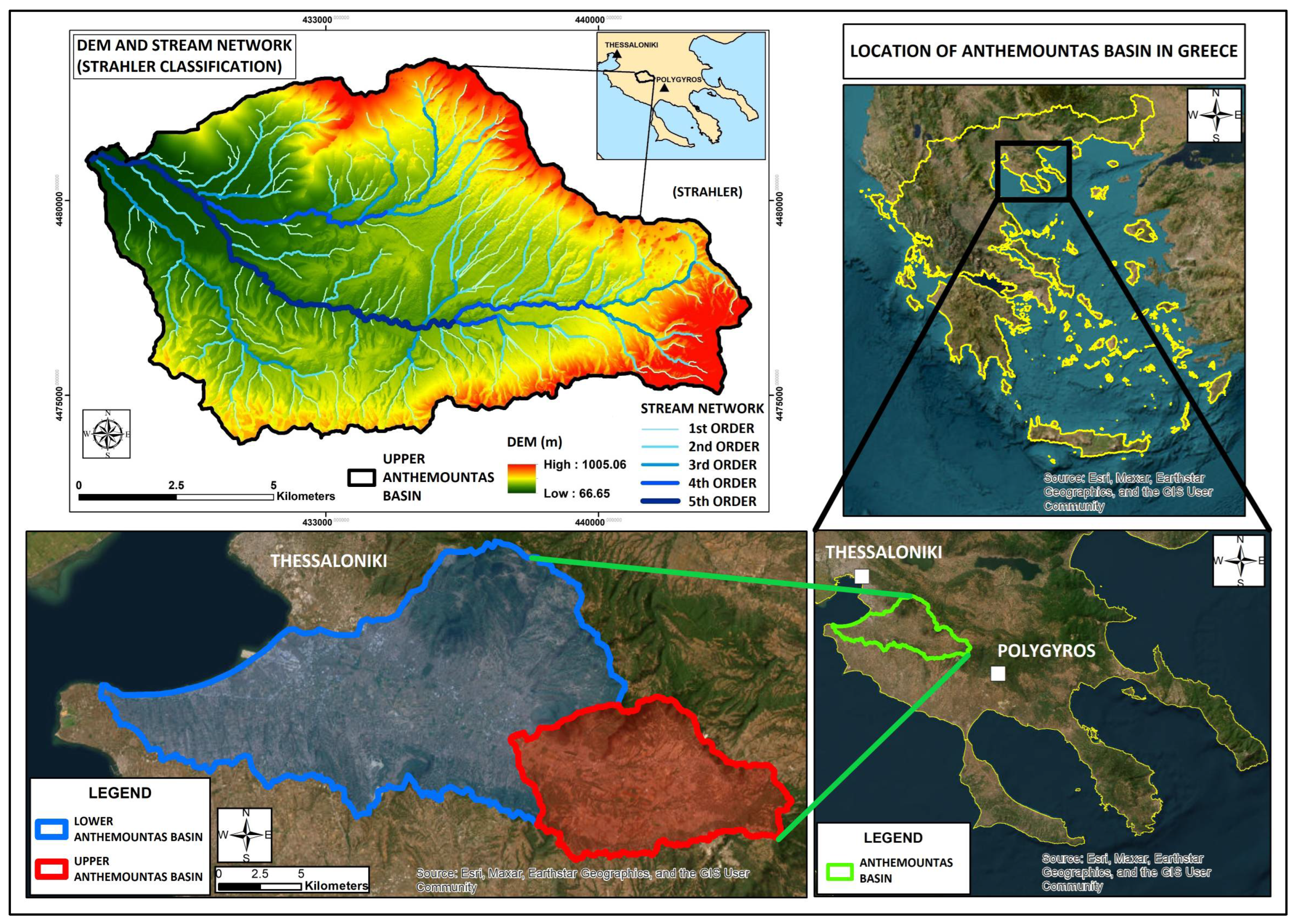
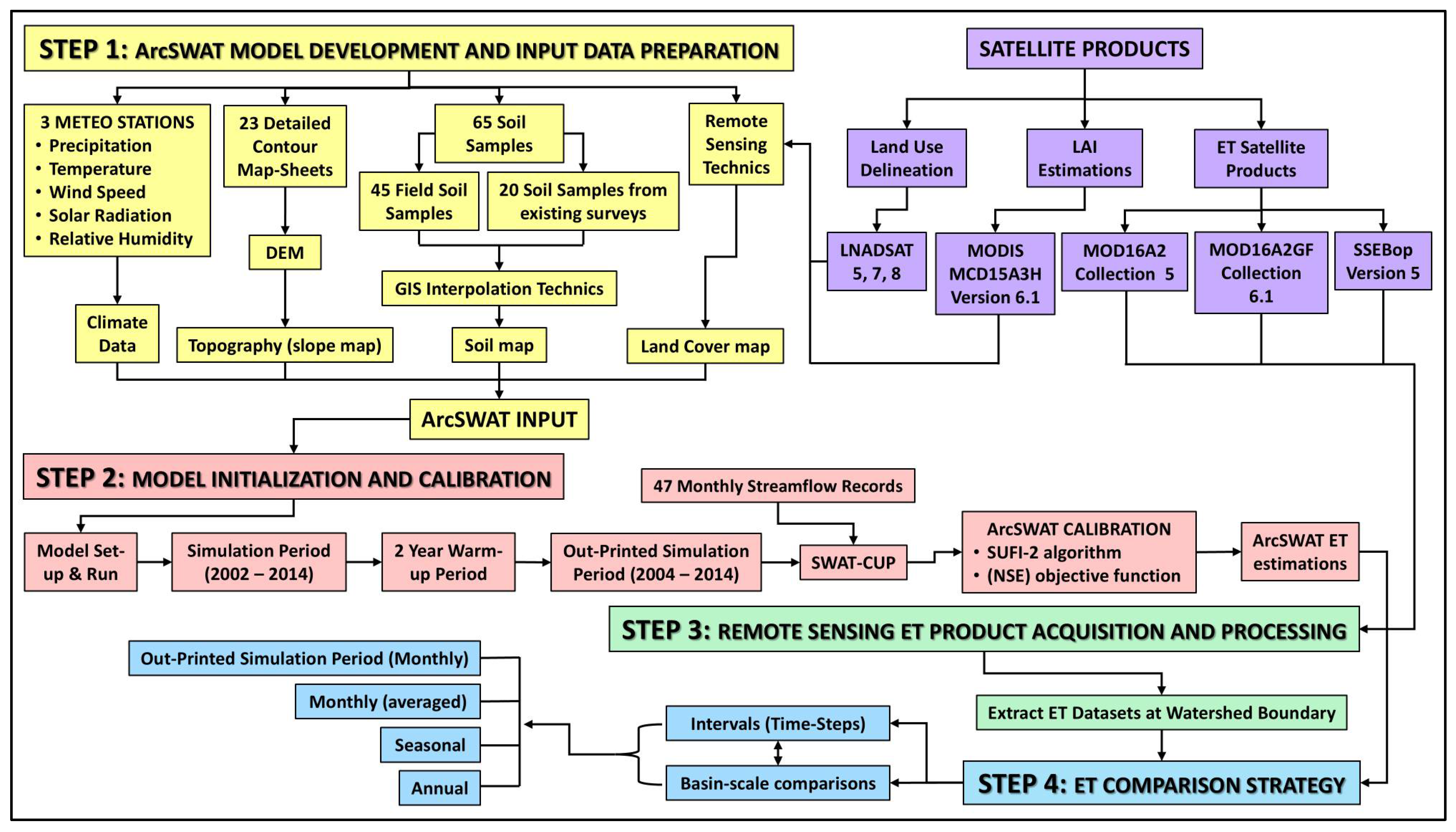
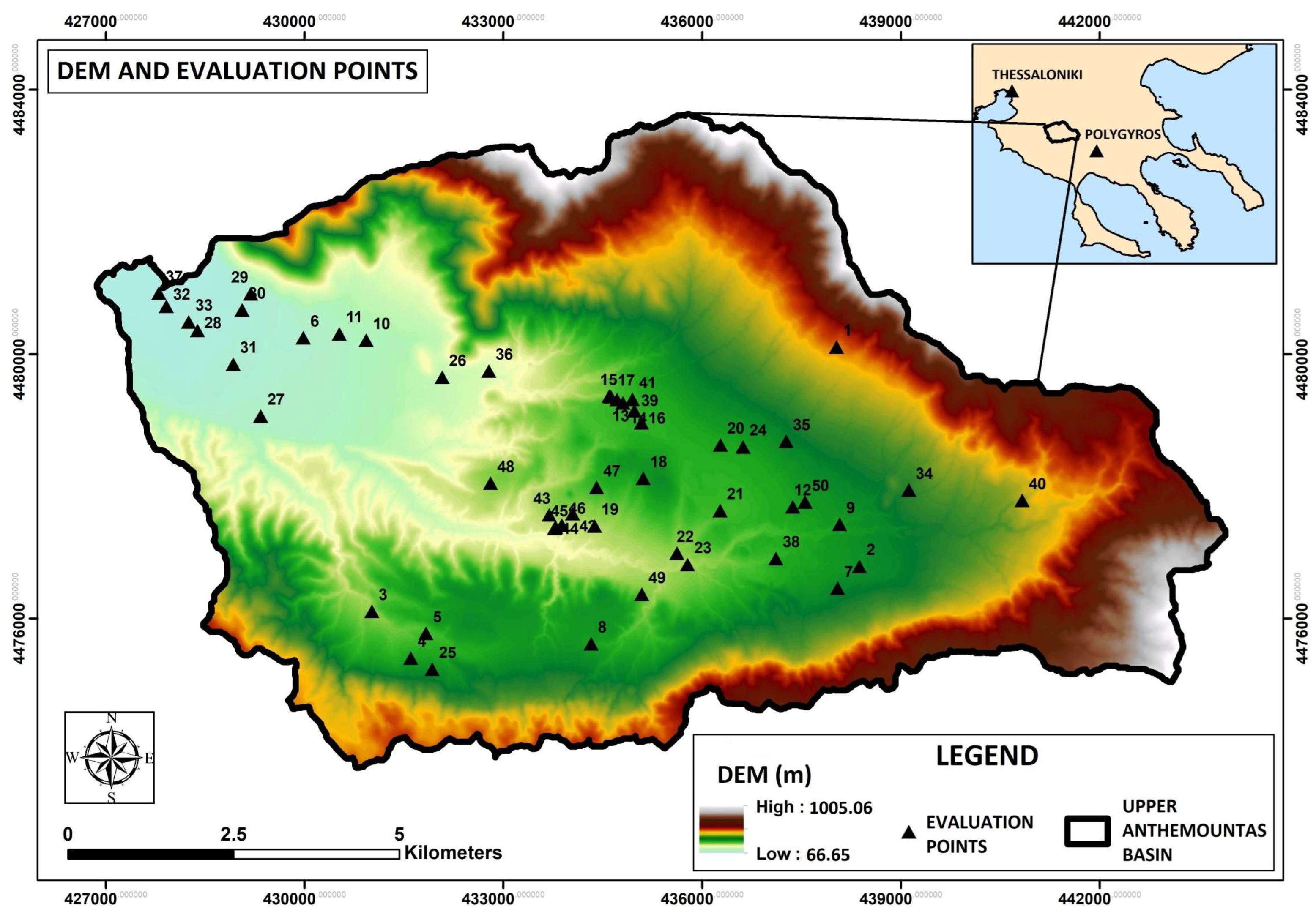
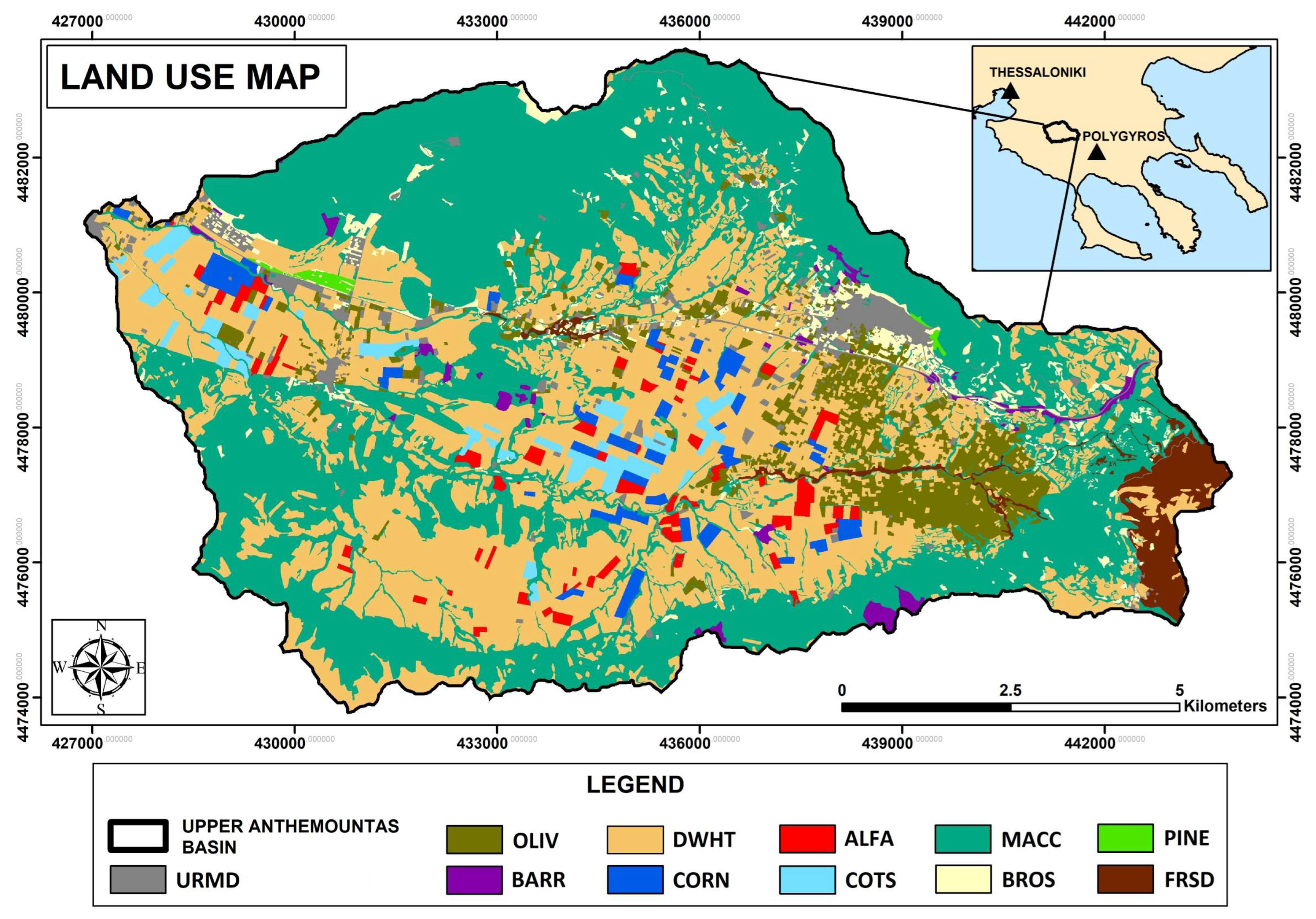

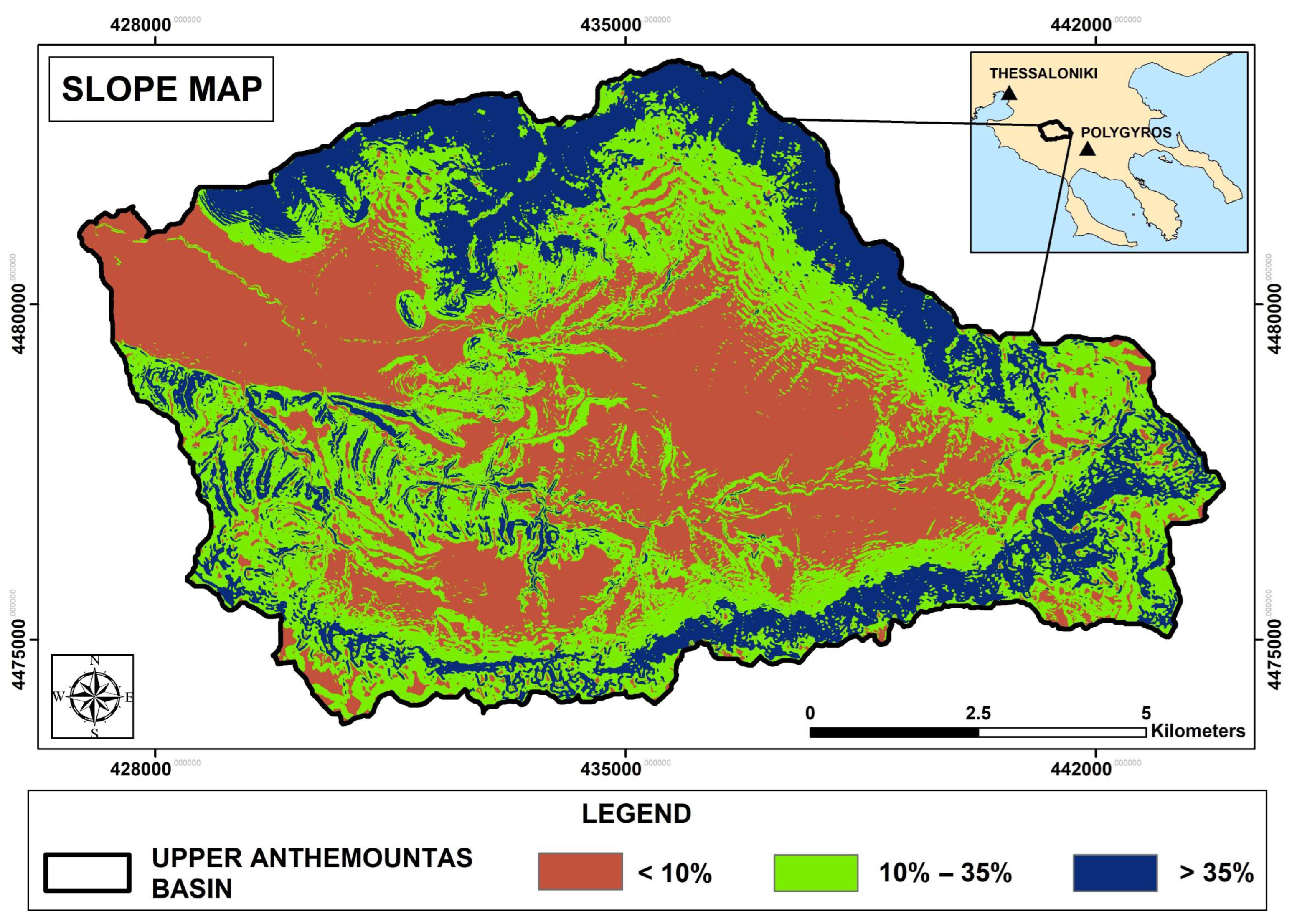
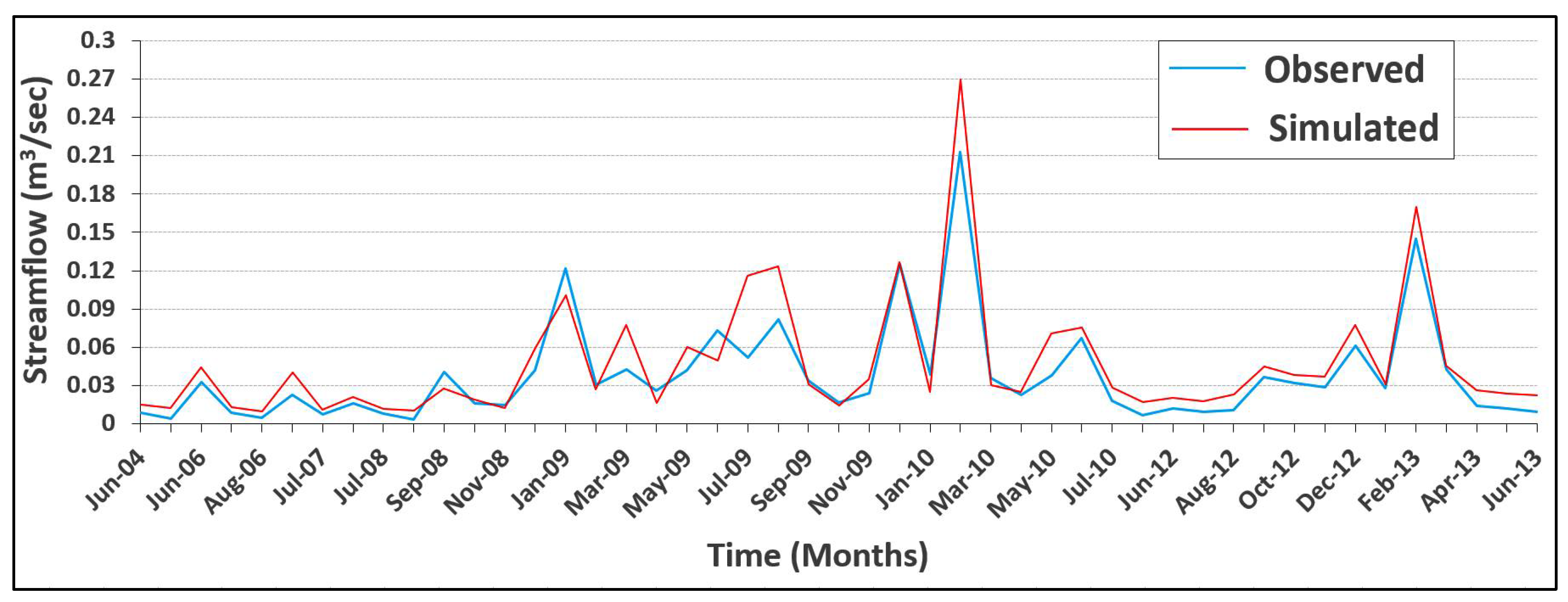

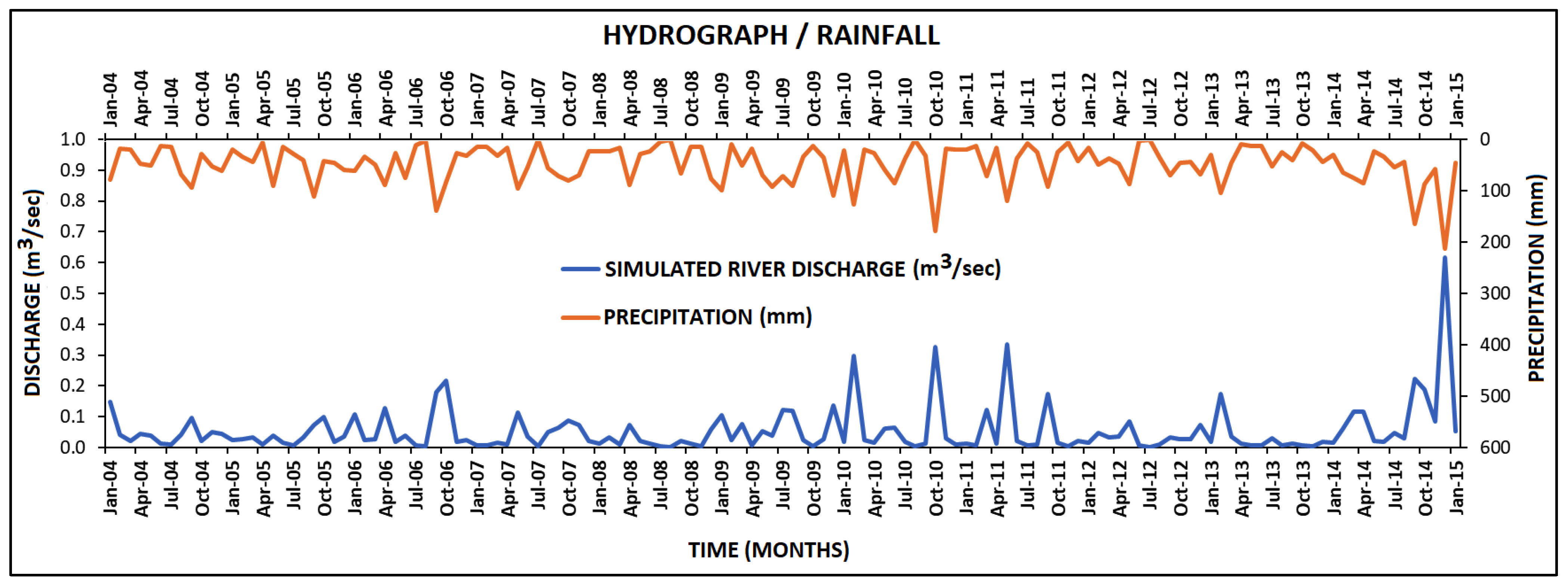

| Mean Elevation (m) | Min Elevation (m) | Max Elevation (m) | Mean Slope (%) | Perimeter (km) | Area (km2) |
|---|---|---|---|---|---|
| 352.3 | 66.7 | 1005.1 | 20.8 | 65.9 | 106.5 |
| Statistical Metrics (Indices) | Formula * | Value Range | Optimal Value |
|---|---|---|---|
| Root Mean Square Error (RMSE) | [0,+∞) | 0 (Lower is better) | |
| Coefficient of Determination (R2) | [0,1] | 1 (Higher is better) | |
| Modified Coefficient of Determination (bR2) | [0,1] | 1 (Higher is better) | |
| Nash–Sutcliffe Efficiency (NSE) | (−∞,1] | 1 (Higher is better) | |
| Modified Nash–Sutcliffe Efficiency (MNS) | (−∞,1] | 1 (Higher is better) | |
| Ratio of the Standard Deviation of Observations to the Root Mean Square Error (RSR) | [0,+∞) | 0 (Lower is better) | |
| Kling–Gupta Efficiency (KGE) | (−∞,1] | 1 (Higher is better) | |
| Percent Bias (PBIAS) | (−∞,+∞) | 0 (Lower absolute value is better) |
| Input Data in the SWAT Model | Data Source |
|---|---|
| Topography | Digitizing and editing twenty-three (23) Hellenic Military Geographical Service (HMGS) elevation map sheets (4 m interval, 1:5000 scale) by using GIS techniques |
| Land Cover | Applying various remote sensing techniques on satellite images (Landsat 5, 7, 8, and MODIS) |
| Soil |
|
| Climate | Data acquired from three (3) stations:
|
| Mean Annual Weather Data | |||||||
|---|---|---|---|---|---|---|---|
| Year | Prec (mm) | Temp (°C) | MIN Temp (°C) | MAX Temp (°C) | RH (%) | WS (m/s) | SR (MJ/m2) |
| 2002 | 730.4 | 15.8 | 10.3 | 21.2 | 66.12 | 1.11 | 11.55 |
| 2003 | 784.3 | 15.5 | 9.9 | 21.0 | 70.09 | 1.07 | 13.21 |
| 2004 | 544 | 15.2 | 9.4 | 21.0 | 68.29 | 1.12 | 15.64 |
| 2005 | 533.1 | 14.7 | 8.8 | 20.6 | 68.07 | 1.99 | 15.44 |
| 2006 | 630.2 | 14.2 | 8.2 | 20.2 | 71.91 | 2.35 | 15.11 |
| 2007 | 525 | 15.3 | 8.9 | 21.6 | 67.73 | 2.32 | 15.52 |
| 2008 | 383.4 | 15.7 | 9.5 | 21.9 | 69.50 | 1.65 | 14.29 |
| 2009 | 693.2 | 15.4 | 9.3 | 21.5 | 73.48 | 1.76 | 14.40 |
| 2010 | 623.6 | 15.7 | 9.8 | 21.5 | 73.70 | 1.06 | 14.87 |
| 2011 | 475.4 | 15.0 | 9.0 | 21.0 | 74.39 | 1.23 | 14.83 |
| 2012 | 504.4 | 16.2 | 10.4 | 22.0 | 68.97 | 1.64 | 15.46 |
| 2013 | 404.6 | 16.0 | 9.8 | 22.2 | 72.76 | 1.56 | 13.95 |
| 2014 | 931.6 | 15.9 | 10.5 | 21.3 | 76.60 | 1.30 | 14.65 |
| Mean | 597.17 | 15.42 | 9.53 | 21.30 | 70.89 | 1.55 | 14.53 |
| SWAT Parameters for “MACC” Classification | Description | Value Range | Selected Value | Source |
|---|---|---|---|---|
| BLAI | Maximum Leaf Area Index | 2.4–3.1 | 2.8 | Analyzing/Editing time series of MODIS LAI images |
| ALAI_MIN | Minimum Leaf Area Index | 0.24–0.35 | 0.3 | |
| T_OPT (°C) | Optimal Temperature for Plant Growth | - | 20 | [57] |
| T_BASE (°C) | Minimum Temperature for Plant Growth | - | 4 |
| Dataset Name | Dataset | Spatial Resolution | Temporal Resolution | Data Source |
|---|---|---|---|---|
| Moderate Resolution Imaging Spectroradiometer (MODIS) Global Terrestrial Evapotranspiration | MOD16A2 (Collection 5) | 1 km | Monthly | http://files.ntsg.umt.edu/data/NTSG_Products/MOD16/MOD16A2_MONTHLY.MERRA_GMAO_1kmALB/ (accessed on 3 January 2023) |
| MOD16A2GF (Collection 6.1) | 0.5 km | 8-day | https://appeears.earthdatacloud.nasa.gov (accessed on 7 January 2023) | |
| Operational Simplified Surface Energy Balance | SSEBop (Version 5) | 1 km | Monthly | https://app.climateengine.org/climateEngine (accessed on 18 January 2023) |
| Index | Evaluation Performance Criteria | Model Performance Results | Model Performance Evaluation | |||
|---|---|---|---|---|---|---|
| Very Good | Good | Satisfactory | Unsatisfactory | |||
| R2 | 0.75 < R2 ≤ 1 | 0.65 < R2 ≤ 0.75 | 0.5 < R2 ≤ 0.65 | R2 ≤ 0.5 | 0.89 | Very Good |
| bR2 | - | - | bR2 ≥ 0.4 | bR2 < 0.4 | 0.8 | Satisfactory |
| NSE | 0.75 < NSE ≤ 1 | 0.65 < NSE ≤ 0.75 | 0.5 < NSE ≤ 0.65 | NSE ≤ 0.5 | 0.79 | Very Good |
| MNS | - | - | MNS ≥ 0.4 | MNS < 0.4 | 0.50 | Satisfactory |
| RSR | 0 ≤ RSR ≤ 0.5 | 0.5 < RSR ≤ 0.6 | 0.6 < RSR ≤ 0.7 | RSR > 0.7 | 0.46 | Very Good |
| KGE | 0.9 ≤ KGE ≤ 1 | 0.75 ≤ KGE < 0.9 | 0.5 ≤ KGE < 0.75 | KGE < 0.5 | 0.69 | Satisfactory |
| PBIAS | PBIAS < ±10 | ±10 ≤ PBIAS < ±15 | ±15 ≤ PBIAS < ±25 | PBIAS ≥ ±25 | −23 | Satisfactory |
| Parameter | Units | Description of the Parameter | Value Range | Fitted Value | |
|---|---|---|---|---|---|
| Min | Max | ||||
| ALPHA_BF | Days | Baseflow alpha factor | 0 | 1 | 0.5 |
| ALPHA_BNK | Days | Baseflow alpha factor for bank storage | 0 | 1 | 0.000167 |
| GWQMN | mm | Threshold depth of water in the shallow aquifer required for return flow to occur | 0 | 5000 | 2383.33 |
| REVAPMN | mm | Threshold depth of water in the shallow aquifer for “revap” to occur | 0 | 500 | 433.67 |
| RCHRG_DP | - | Deep aquifer percolation fraction | 0 | 1 | 0.08 |
| GW_REVAP | - | Groundwater “revap” coefficient | 0.02 | 0.2 | 0.19 |
| OV_N | - | Manning’s “n” value for overland flow | 0.01 | 1 | 0.342 |
| CH_N2 | - | Manning’s “n” value for the main channel | 0 | 0.3 | 0.213 |
| CH_K2 | mm/h | Effective hydraulic conductivity in main channel alluvium | 0 | 500 | 357.5 |
| GW_DELAY | Days | Groundwater delay time | 0 | 500 | 49–192 * |
| ESCO | - | Soil evaporation compensation factor | 0 | 1 | 0.7–0.91 * |
| EPCO | - | Plant uptake compensation factor | 0 | 1 | 0.21–0.8 * |
| SOL_Z | mm | Depth from soil surface to bottom of layer | 0 | 30,000 | 1500 |
| BLAI (MACC) | (kg/ha)/ (MJ/m2) | Maximum potential leaf area index | 0.5 | 10 | 2.55 |
| T_BASE (MACC) | °C | Minimum (base) temperature for plant growth | 0 | 18 | 3 |
| T_OPT (MACC) | °C | Optimal temperature for plant growth | 11 | 38 | 24 |
| CN2 | - | Runoff Curve Number | 30 | 98 | (~−5%) ** |
| Index | Remote Sensing-Derived ET Products | ||
|---|---|---|---|
| MOD16A2-C5 | MOD16A2GF-C6.1 | SSEBop-V5 | |
| KGE | 0.536 | 0.482 | 0.171 |
| PBIAS | 9.95 | 30.18 | −16.81 |
| RMSE | 13.33 | 14.6 | 16.98 |
| RSR | 0.741 | 0.812 | 0.944 |
| Month | Mean Monthly ET (mm) of All Dataset Sources | Average ET (mm) of All Remote Sensing Products | |||
|---|---|---|---|---|---|
| SWAT | MOD16A2-C5 | MOD16A2GF-C6.1 | SSEBop-V5 | ||
| Jan | 16.92 | 24.48 | 24.18 | 7.03 | 18.56 |
| Feb | 20.02 | 24.85 | 26.31 | 6.50 | 19.22 |
| Mar | 30.32 | 38.00 | 40.82 | 10.88 | 29.90 |
| Apr | 35.67 | 53.17 | 58.57 | 33.97 | 48.57 |
| May | 60.83 | 59.72 | 70.99 | 61.61 | 64.11 |
| Jun | 58.54 | 38.92 | 53.96 | 73.72 | 55.53 |
| Jul | 34.05 | 28.88 | 42.94 | 46.82 | 39.55 |
| Aug | 29.13 | 27.34 | 41.19 | 40.00 | 36.18 |
| Sep | 28.98 | 28.86 | 34.98 | 10.68 | 24.84 |
| Oct | 23.53 | 29.49 | 33.94 | 6.18 | 23.20 |
| Nov | 15.82 | 25.78 | 26.70 | 5.10 | 19.19 |
| Dec | 14.01 | 24.94 | 24.26 | 3.52 | 17.58 |
| Mean | 30.65 | 33.70 | 39.90 | 25.50 | 33.04 |
| Season | Seasonal ET (mm) of All Dataset Sources | Average ET (mm) of All Remote Sensing Products | |||
|---|---|---|---|---|---|
| SWAT | MOD16A2-C5 | MOD16A2GF-C6.1 | SSEBop-V5 | ||
| Winter | 49.96 | 72.23 | 72.56 | 16.61 | 53.80 |
| Spring | 126.82 | 150.90 | 170.38 | 106.46 | 142.58 |
| Summer | 121.72 | 95.13 | 138.09 | 160.54 | 131.26 |
| Fall | 68.33 | 84.13 | 95.63 | 21.96 | 67.24 |
| Year | Annual ET (mm) of All Dataset Sources | Average ET (mm) of All Remote Sensing Products | |||
|---|---|---|---|---|---|
| SWAT | MOD16A2-C5 | MOD16A2GF-C6.1 | SSEBop-V5 | ||
| 2004 | 385.88 | 395.30 | 460.10 | 258.71 | 371.37 |
| 2005 | 403.80 | 397.44 | 460.30 | 217.58 | 358.44 |
| 2006 | 399.12 | 444.92 | 510.64 | 361.54 | 439.03 |
| 2007 | 387.37 | 395.89 | 461.24 | 293.25 | 383.46 |
| 2008 | 298.90 | 391.13 | 476.54 | 317.13 | 394.94 |
| 2009 | 445.84 | 421.19 | 499.46 | 371.29 | 430.65 |
| 2010 | 366.71 | 432.50 | 511.20 | 396.10 | 446.60 |
| 2011 | 308.20 | 390.17 | 481.72 | 322.47 | 398.12 |
| 2012 | 344.75 | 362.77 | 434.38 | 258.22 | 351.79 |
| 2013 | 304.54 | 384.35 | 459.85 | 257.66 | 367.29 |
| 2014 | 401.02 | 433.21 | 511.91 | 312.11 | 419.07 |
| Mean | 367.83 | 404.44 | 478.85 | 306.00 | 396.43 |
Disclaimer/Publisher’s Note: The statements, opinions and data contained in all publications are solely those of the individual author(s) and contributor(s) and not of MDPI and/or the editor(s). MDPI and/or the editor(s) disclaim responsibility for any injury to people or property resulting from any ideas, methods, instructions or products referred to in the content. |
© 2025 by the authors. Licensee MDPI, Basel, Switzerland. This article is an open access article distributed under the terms and conditions of the Creative Commons Attribution (CC BY) license (https://creativecommons.org/licenses/by/4.0/).
Share and Cite
Sevastas, S.; Siarkos, I.; Mallios, Z. A Comparative Analysis of Remotely Sensed and High-Fidelity ArcSWAT Evapotranspiration Estimates Across Various Timescales in the Upper Anthemountas Basin, Greece. Hydrology 2025, 12, 171. https://doi.org/10.3390/hydrology12070171
Sevastas S, Siarkos I, Mallios Z. A Comparative Analysis of Remotely Sensed and High-Fidelity ArcSWAT Evapotranspiration Estimates Across Various Timescales in the Upper Anthemountas Basin, Greece. Hydrology. 2025; 12(7):171. https://doi.org/10.3390/hydrology12070171
Chicago/Turabian StyleSevastas, Stefanos, Ilias Siarkos, and Zisis Mallios. 2025. "A Comparative Analysis of Remotely Sensed and High-Fidelity ArcSWAT Evapotranspiration Estimates Across Various Timescales in the Upper Anthemountas Basin, Greece" Hydrology 12, no. 7: 171. https://doi.org/10.3390/hydrology12070171
APA StyleSevastas, S., Siarkos, I., & Mallios, Z. (2025). A Comparative Analysis of Remotely Sensed and High-Fidelity ArcSWAT Evapotranspiration Estimates Across Various Timescales in the Upper Anthemountas Basin, Greece. Hydrology, 12(7), 171. https://doi.org/10.3390/hydrology12070171







